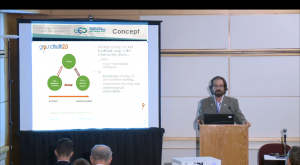Citizen Science Side Event at GEO Plenary 2017
The Group on Earth Observations (GEO) had its plenary Meeting in Washington DC (USA) last October 23-27th. In 2017, the Program Board of GEO approved a new GEO activity to work on the integration of Citizen Science in GEOSS. The first event of this group was the organization of a side event at the GEO Plenary 2017 with the title “The Role of Citizen Observatories and Crowdsourcing Community in GEOSS”, with the support of Ground Truth 2.0 from the European side and from the Secure World Foundation, South Big Data Innovation Hub, and The Wilson Center for the US side. The record of the session can be found here: https://www.youtube.com/watch?v=qoMW4keAz9o&feature=youtu.be.
 After some welcome remarks, we had a first block of Lightning Talks about Citizen Science Programs and Observatories, moderated by Dr. Lea Shanley, South Big Data Innovation Hub. Maria Krommyda presented one of the Citizen Observatories from the recent EC project Scent, focused on floods in rivers, Mikel Maron provided a view on how Open Street Maps can be useful in humanitarian campaigns, Laetitia Navarro showed the usefulness of Citizen Science for recording biodiversity and reinforcing time series. Joan Masó presented another of the recent EC projects: Ground Truth 2.0 and its 6 demo cases. Andreas Matheus from Secure Dimensions GmbH exposed how we can create a federation of sign-on systems that allows citizens to authenticate only once in the network.
After some welcome remarks, we had a first block of Lightning Talks about Citizen Science Programs and Observatories, moderated by Dr. Lea Shanley, South Big Data Innovation Hub. Maria Krommyda presented one of the Citizen Observatories from the recent EC project Scent, focused on floods in rivers, Mikel Maron provided a view on how Open Street Maps can be useful in humanitarian campaigns, Laetitia Navarro showed the usefulness of Citizen Science for recording biodiversity and reinforcing time series. Joan Masó presented another of the recent EC projects: Ground Truth 2.0 and its 6 demo cases. Andreas Matheus from Secure Dimensions GmbH exposed how we can create a federation of sign-on systems that allows citizens to authenticate only once in the network.
The second block was a panel to talk about Tools, Best Practices, and Standards for Utilizing Citizen Science for GEOSS, moderated by Krystal Wilson, Secure World Foundation. Anne Bowser exposed the opportunity to integrate  several mosquito related projects in a Global Mosquito Alert system. Dixon Butler emphasized the role of Citizen Science in Youth Learning. Max Craglia presented the interest of the European Commission to connect the Citizen Observatories with GEOSS and used the MyGEOSS projects as examples, Steffen Fritz presented several initiatives in IIASA including LandSense (one of the recent EC CO projects; the others being Ground Truth 2.0, Scent and Grow).
several mosquito related projects in a Global Mosquito Alert system. Dixon Butler emphasized the role of Citizen Science in Youth Learning. Max Craglia presented the interest of the European Commission to connect the Citizen Observatories with GEOSS and used the MyGEOSS projects as examples, Steffen Fritz presented several initiatives in IIASA including LandSense (one of the recent EC CO projects; the others being Ground Truth 2.0, Scent and Grow).
The event concluded with a group discussion to set up initial activities and priorities for the GEO Activity about Citizen Science, moderated by Joan Masó, member of CREAF and participant in Ground Truth 2.0. The group agreed that in the next year we should focus on:
- Developing a white paper on how citizen science can contribute to the SDG indicators and the SDG implementation. This activity is led by IIASA;
- Developing a list of citizen science projects that showcase the usefulness of CS for the GEOSS objectives. This activity is led by SWF and SBDIH;
- Creating a community of practice about interoperability for CS. Design and execute an interoperability experiment to illustrate a methodology to expose CS data as SWE, Single Sign on and scale up by merging. This activity is led by CREAF in the framework of the WeObserve project.
The GEO Activity on Citizen Science is looking for contributions for these initial tasks. If you are interested in collaborating with the activity, please contact the GEO secretariat.
Ground Truth 2.0 was also proudly presented in the EC’s official statement.
